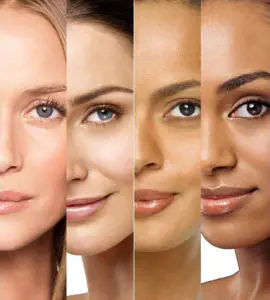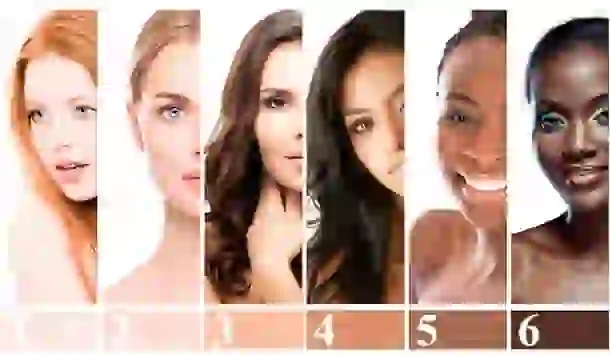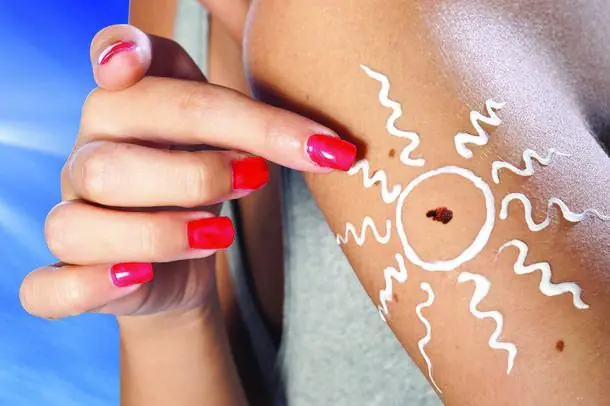
Skin phototypes characterize its sensitivity to solar (or rather, ultraviolet) radiation and the degree of changes occurring under its influence. The phototype is genetically predetermined (innate) and does not change throughout life even when exposed to strong external or internal factors. Its biological basis is the level of reaction of melanocytes - cells located in the lower layers of the epidermis and producing melanin. This pigment causes tanning; it is also “responsible” for the presence of moles and freckles. In addition, eye color depends on its quantity and nature of distribution in the iris.
Practical significance of phototypes
It is advisable for every person to find out their skin phototype, since this has a direct bearing not only on external beauty, but also on health. For example, it is considered statistically significant that the development of certain types of skin tumors is directly related to the level of ultraviolet radiation absorbed by the dermis. Among them is the most malignant tumor – melanoma. These facts have been confirmed through scientific and medical experiments.
Knowing your skin phototype allows you to:
- determine a safe regime for staying in the sun or in a solarium, which will result in an even and lasting tan and no burns;
- choose the right products with a sufficient level of sun protection index SPF (Sun Protection Factor);
- undergo cosmetic procedures associated with dosed damage to the skin (chemical or laser peeling) without complications;
- avoid skin photoaging;
- significantly reduce the risk of oncodermatological diseases.
Fitzpatrick classification
There are many gradations and systems that define the so-called “skin passport”. One of the most convenient and widespread of them is the classification of the famous American dermatologist Thomas B. Fitzpatrick, developed in 1975. His scale divides all people into 6 categories depending on the saturation of the dermis with melanin and its reaction to the action of ultraviolet radiation. In addition to the natural color of the skin, Fitzpatrick phototype takes into account hair and eye color . 
I phototype
Skin: very light, sometimes translucent, milky white or with a porcelain tint, easily blushing when nervous; often with a large number of freckles. Representatives of this category have a feature - light nipples, which is due to the low melanin content in these areas. This skin type is typical for Europeans.
Hair: Almost always very blond or red.
Eyes: blue, gray or green.
Reaction to ultraviolet light: maximum photosensitivity. Since the pigment is formed in small quantities, after just a quarter of an hour of exposure to the sun, signs of a first-degree burn (hyperemia and burning) may appear. Subsequently, peeling occurs, and residual hyperpigmentation may persist for a long time. An even tan is almost unattainable.
Recommendations: Since this phototype has the highest risk of developing skin cancer, it is advisable to always avoid exposure to sunlight. If sun exposure is necessary, it is mandatory to use photoprotective products with a high protection factor (SPF from 30 to 50). Increased caution should be exercised when undergoing laser or chemical peels as there is a high likelihood of developing hyperpigmentation and long-term irritation. Typically, procedures with a mild and superficial effect are prescribed.
Famous representatives with skin phototype I: Nicole Kidman, Claudia Schiffer, Renee Zellweger, Scarlett Johansson, Julianne Moore.


III phototype
Names: Central European, dark European, mixed, dark European.
Skin: slightly dark, with an olive or ivory tint, practically without freckles.
Hair: shades of chestnut, dark brown, rarely black.
Eyes: gray, brown.
Reaction to ultraviolet light: tanning occurs easily and quickly with the formation of a moderately dark shade; however, burns may occur with excessive initial exposure to the sun (more than half an hour).
Recommendations: rational insolation regime, especially when suddenly moving to southern latitudes. Solarium: exposure up to 25 minutes with one to two day breaks. Use of protective products with high or moderate SPF (from 15 to 25).
Representatives: Angelina Jolie, Elizabeth Hurley, Natalie Portman, Kristin Davis.


IV phototype
Names: Mediterranean, Southern European.
Skin: dark, olive, no freckles. The phototype is typical for residents of Latin America, Asia, the Caucasus and the Mediterranean.
Hair: dark brown or black.
Eyes: brown, dark brown or black.
Reaction to ultraviolet radiation: the skin has high natural protection (about 40 minutes); A pronounced and lasting tan quickly appears. Sunburn is very rare, but prolonged exposure to high doses of ultraviolet radiation can cause photoaging of the skin.
Recommendations: use light protective agents (SPF from 8 to 20) to prevent solar aging. Solarium: to get a good tan, you can do 10 half-hour sessions (daily or at daily intervals).
Celebrities: Monica Bellucci, Penelope Cruz, Salma Hayek, Jennifer Lopez, Eva Longloria.


V phototype
Names: Middle Eastern, Indonesian, Asian.
Skin: dark, dark brown, possible yellowish tint; no freckles. The phototype is found mainly in residents of Southeast Asia and many Latin American countries.
Hair: dark brown or black.
Eyes: dark brown or black.
Reaction to ultraviolet radiation: a high degree of natural skin protection; sunburn is extremely rare (this only happens with very intense and prolonged exposure to ultraviolet radiation). The acquired tan is almost invisible against the background of natural pigmentation.
Recommendations: minimal protection may be necessary when exposed to strong sunlight after a long break (use products with SPF of about 10). Since there is a high probability of hyperpigmentation, some cosmetic procedures should be carried out with caution - for example, many options for chemical or laser peeling (the same applies to skin phototype VI).
Notable representatives: Nicole Scherzinger, Michelle Yeoh, Lucy Liu.


VI phototype
Names: African American, African.
Skin: dark brown or blue-black. The phototype is characteristic of people from the African continent and the aborigines of Australia.
Eyes: dark brown or black.
Reaction to ultraviolet radiation: natural skin protection from UV exposure can be considered ideal, since it allows you to constantly be exposed to direct rays of the sun without any damage; Photoburns never happen.
Recommendations: use nourishing and moisturizing agents if necessary. Artificial photoprotection is not required. It is necessary to evaluate contraindications when using most types of peeling and hair removal (there is a high risk of hyperpigmentation).
Celebrities: Naomi Campbell, Tina Turner, Whoopi Goldberg.


Skin phototypes should be taken into account when choosing an adequate and safe tanning regimen, purchasing photoprotective products and undergoing certain cosmetic procedures. This will prevent burns, preserve beauty and protect health.
Dear visitors to our website, if you have had this or that operation (procedure) or used any product, please leave your review. It can be very useful to our readers!
It is known that some people tan instantly in the sun, while others spend the whole day on the beach, but cannot boast of a beautiful tan.
It's all about the skin phototype, which is genetically predetermined and does not change even under the influence of the strongest factors.
The skin phototype represents the degree of sensitivity of the skin to the effects of ultraviolet radiation. It depends on the amount of pigment produced in the lower layers of the epidermis - melanin.
It is melanin that is responsible for tanning, the presence of moles or freckles on the skin. Skin phototype and tan are very closely related. To better understand this connection, it is necessary to understand how tanning occurs.
On the surface of the skin there are melanocytes - cells that are filled with the pigment melanin, making the skin shade darker. With information about skin photosensitivity, people can:
- protect yourself while in the sun by making contact with ultraviolet rays safe and enjoyable;
- choose suitable sunscreens;
- get a beautiful tan without burns and age spots;
- determine the time of safe exposure to the sun.
Skin phototypes according to Fitzpatrick: table on how to determine your phototype
How to determine your skin phototype: Fitzpatrick table
Today there are many conventional classifications that describe the characteristic features of a certain skin phototype. The most convenient is the phototype table developed by American professor Thomas Fitzpatrick in 1975.
According to his theory, there are six types of photosensitivity, four of which are most common among Europeans. You can determine the type of photosensitivity of your own skin based on external signs.
However, if you have any doubts, you can contact a dermatologist who will conduct a diagnosis, determine the skin passport, determine the optimal time spent in direct sunlight and select suitable means for safe tanning.
Representatives of the Celtic type have blue or light green eyes, they are usually blonde or red. Their skin has a milky, sometimes porcelain color and is covered with a large number of freckles. As a result of adverse effects, as well as nervous overstrain, the skin turns red. In Scotland or Ireland, representatives of this phototype are most often found.
The most striking examples of famous people with Celtic skin type are: Scarlett Johansson, Renee Zellweger, Nicole Kidman, Claudia Schiffer.
Characteristic signs of the Scandinavian type of photosensitivity are gray, green or blue eyes and brown hair. The skin of those with the second phototype is light in color and sometimes has freckles. People with this skin type can be found in Europe and Scandinavia.
The most prominent known representatives of the Nordic phototype are: Cameron Diaz, Marilyn Monroe, Charlize Theron.
Representatives of this type of sun sensitivity always have dark skin, dark brown or light brown hair, and their eyes are brown or gray. Vivid examples of celebrities with a dark European phototype are: Natalie Portman, Angelina Jolie, Audrey Hepburn.
Representatives of this skin phototype live mainly in Latin America and Spain. This type of photosensitivity is characterized by dark skin with a complete absence of freckles, brown eyes and dark, almost black hair. Celebrities: Salma Hayek, Eva Longoria, Penelope Cruz, Monica Bellucci.
People with the fifth type of photosensitivity live mainly in Eastern countries. They never burn in the sun, since their skin is already dark. Almost all people with the fifth phototype have black hair and brown eyes. Famous representatives of the Middle Eastern phototype: Nicole Scheisinger, Reon Cadena, Lucy Liu.
Africans and African Americans have skin with this type of photosensitivity to the sun. Representatives of this phototype are distinguished by a very dark skin tone, their hair is always black, and their eyes are dark brown.
Bright and famous owners of African-American skin type are: Naomi Campbell, Beyoncé, Halle Berry.
Depending on the color and sensitivity of the skin to ultraviolet radiation, several phototypes are distinguished. Several criteria are used to designate them. Together, they make it possible to determine the skin phototype according to the Fitzpatrick scale. This system is most often used in dermatology and cosmetology when it comes to the effect of artificial or natural ultraviolet radiation on the skin.
p, blockquote 1,0,0,0,0 —>
p, blockquote 2,0,0,0,0 —>
The phototype is an innate characteristic; it does not change throughout life and depends on the amount and distribution of melanin pigment in the dermis. This substance has a dark color and determines the color of the skin, hair and iris of the eyes. Under the influence of ultraviolet radiation, the amount of melanin increases and tanning occurs. Moles and freckles are caused by focal accumulations of melanin in the cells of the epidermis. Gradually, the cells containing such accumulations peel off and the tan disappears. Also, the number, shape and size of age spots may change throughout life.
p, blockquote 3,0,0,0,0 —>
Pale skin of the first phototype tans slowly and poorly, but quickly becomes irritated and turns red when exposed to sunlight. She needs more intensive protection. Darker phototypes perceive tanning better, but when UV burns occur, they are prone to the formation of foci of pigmentation.
p, blockquote 4,0,0,0,0 —>

p, blockquote 5,0,0,0,0 —>
What is the Fitzpatrick scale
The Fitzpatrick skin phototype test is a scientific classification that is aimed at determining acceptable levels of ultraviolet exposure.
p, blockquote 6,0,0,0,0 —>
The scale was developed in 1975. She classifies all types of skin tones depending on the amount of pigment and reaction to sunlight. Such information is useful in determining the risk of sunburn and skin cancer.
p, blockquote 7,0,0,0,0 —>
After determining the individual level of risk, you can choose the right sunscreen and find out the permissible duration of insolation.
p, blockquote 8,0,0,0,0 —>
Determination of phototypes
In everyday life, this is necessary primarily for the correct choice of sunscreens.
p, blockquote 9,0,0,0,0 —>
How to find out your skin phototype? To do this, you can use the tables below. They take into account 3 main factors:
p, blockquote 10,0,1,0,0 —>
- genetically determined external signs;
- sensitivity to sun exposure;
- features of tanning.
So, you need to determine the appropriate characteristics from the tables, write down and add up the points corresponding to them, and then compare the result with the final table.
p, blockquote 11,0,0,0,0 —>
External signs:
p, blockquote 12,0,0,0,0 —>

p, blockquote 13,0,0,0,0 —>
Sun sensitivity:
p, blockquote 14,0,0,0,0 —>

p, blockquote 15,0,0,0,0 —>
Tanning Features:
p, blockquote 16,0,0,0,0 —>

p, blockquote 17,0,0,0,0 —>
Final table:
p, blockquote 18,0,0,0,0 —>

p, blockquote 19,0,0,0,0 —>
Phototypes and aging
For all phototypes, exposure to sunlight is a damaging factor. Under its influence, the structure and elasticity of the dermis is lost, facial wrinkles are formed, pigment spots and uneven coloring of the epidermis appear. Excessive sun exposure is a risk factor for melanoma.
p, blockquote 20,0,0,0,0 —>
Phototypes 1 and 2 are characterized by a very small amount of melanin pigment in the cells. Melanin absorbs sun rays, protecting the skin. Therefore, people with these types should avoid the sun and use high SPF sunscreens. These types are characterized by the appearance of freckles and are more susceptible to premature photoaging.
p, blockquote 21,1,0,0,0 —>
Phototypes 3 and 4 have more melanin in their cells, distributed evenly. Therefore, freckles are not typical for them. Photoaging processes for these types include expression lines (forming later than in people with lighter skin), lentigines, and the formation of melasma (a type of age spots). People of this type can easily sunbathe without overexposing themselves to the sun and always use sunscreen.
p, blockquote 22,0,0,0,0 —>
Phototypes 5 and 6 not only contain a lot of melanin. Their dermis layer is thicker and denser than that of fair-skinned people, and it contains more moisture. As a result, expression lines appear later. As they age, such people are prone to developing melasma. “Dark” phototypes are characterized by a higher rate of epidermal renewal, so such people need good regular cleansing of the skin.
p, blockquote 23,0,0,0,0 —>
Health risks and their prevention
Tanning beds and other artificial sources of ultraviolet rays are harmful to all people. Studies have shown that with frequent visits before the age of 35, the risk of skin cancer (melanoma) increases by 75 times.
p, blockquote 24,0,0,0,0 —>

p, blockquote 25,0,0,0,0 —>
The sun is also harmful to the skin. The closer to the equator the place of residence, the higher doses of radiation a person receives. Therefore, in the south, sun protection is extremely important. During the summer months, even residents of temperate latitudes are advised to use sunscreen daily.
p, blockquote 26,0,0,0,0 —>
1 – 2 phototypes
p, blockquote 27,0,0,0,0 —>
People with light, poorly tanned skin and light hair are often grouped under this name. With the Celtic and Scandinavian types, the risk of sunburn, rapid photoaging and the development of melanoma increases.
p, blockquote 28,0,0,0,0 —>
People with phototype 1 or 2 are recommended:
p, blockquote 29,0,0,0,0 —>
- use sunscreen with SPF 30 or more (in bright sun - 50);
- limit exposure to the sun, stay in the shade more;
- wear wide-brimmed hats to protect the neck and face;
- use high-quality sunglasses with anti-UV lenses;
- if you need to be in the sun for a long time, wear special protective clothing marked UPF 30 or more;
- monthly, thoroughly examine the skin, paying attention to the color and size of moles and freckles;
- be examined annually by a dermatologist so as not to miss the early stage of melanoma, since melanoma can be non-pigmented and difficult to notice.
3 – 6 phototypes
p, blockquote 30,0,0,0,0 —>
With phototypes 3–6, the likelihood of melanoma increases mainly when visiting solariums.
p, blockquote 31,0,0,1,0 —>
Even people with very dark skin are not protected from melanoma. However, their cancer is diagnosed at a later stage, which worsens the prognosis of the disease.
p, blockquote 32,0,0,0,0 —>
In our climate, phototypes 2 and 3 are more common, and phototype 4 is less common. For maximum protection against melanoma and sunburn, such people are also recommended to use the protection measures listed above and choose sunscreens with an SPF of at least 15.
p, blockquote 33,0,0,0,0 —>
It is necessary to carefully examine the skin every month. Phototypes 4 and 5 are characterized by the appearance of acral lentiginous melanoma. At first, the tumor appears as a thickening in areas not exposed to sunlight. It is usually discovered at a late stage. Therefore, self-control is extremely important for the prevention of this disease. It is also recommended to be examined by a dermatologist annually.
p, blockquote 34,0,0,0,0 —>
Phototypes in cosmetology
In addition to the features of care and sun protection, phototypes are taken into account when using a variety of light cosmetology techniques, primarily laser. The action of pulsed light with a certain wavelength, that is, a laser, is used by cosmetologists for cleansing, lifting, hair removal and other purposes. Before using such techniques, the cosmetologist must take into account the skin phototype.
p, blockquote 35,0,0,0,0 —>

Incorrectly selected laser beam power can lead to burns.
How to determine the skin phototype for laser hair removal?
p, blockquote 36,0,0,0,0 —>
To do this, you need to use the Fitzpatrick tables given above. However, this technique does not always give an accurate result, since the points scored may fall on the border of phototypes, or the characteristics of the skin will be determined incorrectly. Therefore, when working on open areas, a preliminary test is used, irradiating a limited area of the epidermis with a laser at the intended site of exposure.
p, blockquote 37,0,0,0,0 —>
The result is assessed after a week for people of phototypes 1-3, after 2 weeks for people of the 4th and after 21 days for people of the 5th and 6th. This allows the doctor to confidently select the safe power of the laser beam for hair removal or other procedures.
p, blockquote 38,0,0,0,0 —>
Features of visiting a solarium and some cosmetic procedures:
p, blockquote 39,0,0,0,0 —>
- With phototype 1, a minimum radiation power is required, since such skin is prone to burns. Visiting the solarium is not recommended.
- With phototype 2, the radiation power is selected individually. Sunbathing in a solarium is also not recommended, but if such a procedure is carried out, the insolation time should not exceed 15 minutes a day with a break of 2 days.
- 3rd phototype: the duration of sessions should not exceed 25 minutes; the break between them is at least a day.
- 4th phototype: permissible time - half an hour a day, daily or with an interval of 1 day.
- 5th phototype: usually a tan forms naturally, without visiting a solarium. However, when carrying out peeling, including laser, you need to be careful. Pigment spots form on such skin quite easily.
- 6th phototype: the basis of care is moisturizing and cleansing; when performing laser procedures, there is a high risk of pigmentation disorders.
p, blockquote 40,0,0,0,0 —>
To prevent laser radiation from triggering the uncontrolled formation of melanin under the influence of street sunlight, it is better to plan such procedures in winter. In the next 2 - 3 months, you should protect yourself from ultraviolet radiation with special means and not sunbathe.
p, blockquote 41,0,0,0,0 —> p, blockquote 42,0,0,0,1 —>
">



